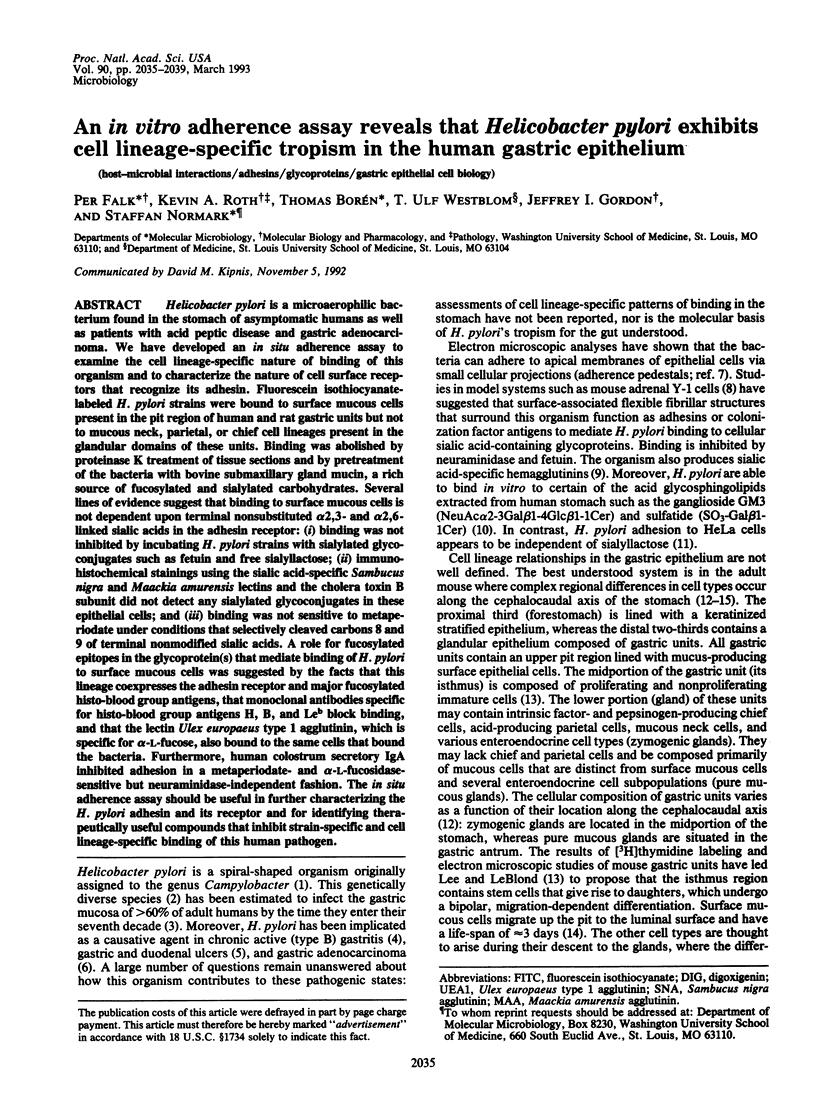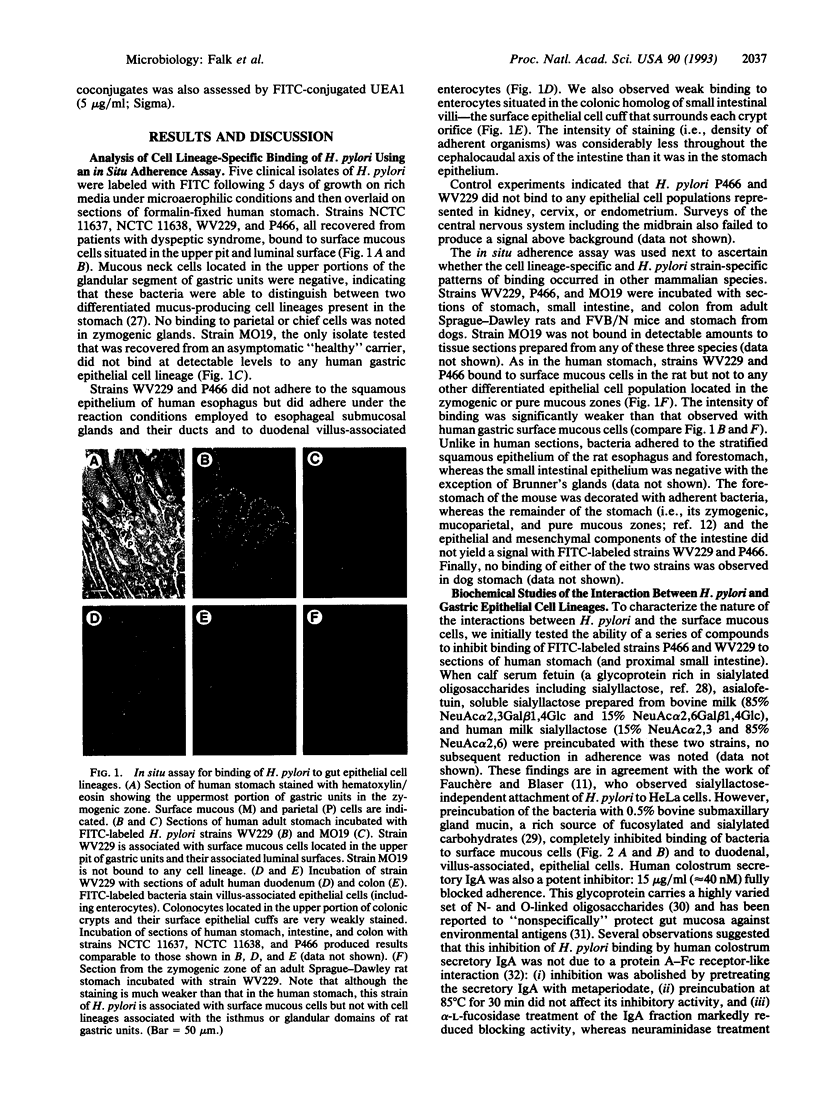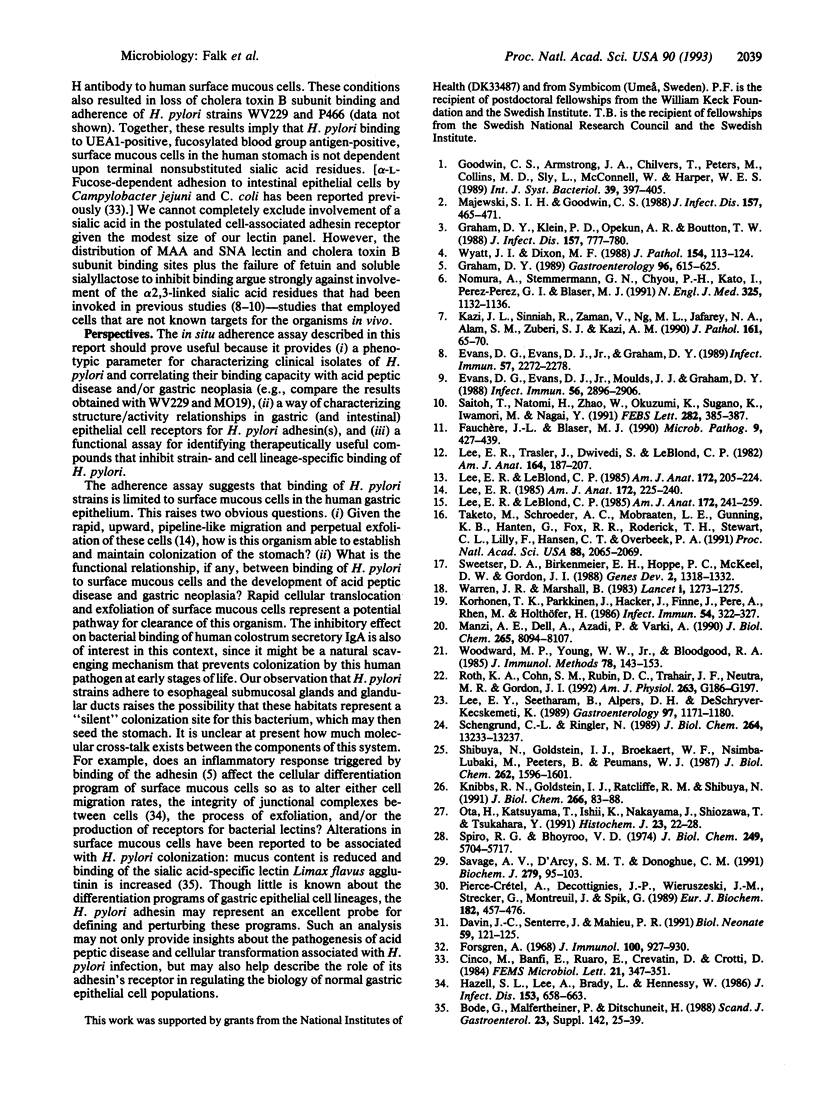Abstract
Helicobacter pylori is a microaerophilic bacterium found in the stomach of asymptomatic humans as well as patients with acid peptic disease and gastric adenocarcinoma. We have developed an in situ adherence assay to examine the cell lineage-specific nature of binding of this organism and to characterize the nature of cell surface receptors that recognize its adhesin. Fluorescein isothiocyanate-labeled H. pylori strains were bound to surface mucous cells present in the pit region of human and rat gastric units but not to mucous neck, parietal, or chief cell lineages present in the glandular domains of these units. Binding was abolished by proteinase K treatment of tissue sections and by pretreatment of the bacteria with bovine submaxillary gland mucin, a rich source of fucosylated and sialylated carbohydrates. Several lines of evidence suggest that binding to surface mucous cells is not dependent upon terminal nonsubstituted alpha 2,3- and alpha 2,6-linked sialic acids in the adhesin receptor: (i) binding was not inhibited by incubating H. pylori strains with sialylated glycoconjugates such as fetuin and free sialyllactose; (ii) immunohistochemical stainings using the sialic acid-specific Sambucus nigra and Maackia amurensis lectins and the cholera toxin B subunit did not detect any sialylated glycoconjugates in these epithelial cells; and (iii) binding was not sensitive to metaperiodate under conditions that selectively cleaved carbons 8 and 9 of terminal nonmodified sialic acids. A role for fucosylated epitopes in the glycoprotein(s) that mediate binding of H. pylori to surface mucous cells was suggested by the facts that this lineage coexpresses the adhesin receptor and major fucosylated histo-blood group antigens, that monoclonal antibodies specific for histo-blood group antigens H, B, and Leb block binding, and that the lectin Ulex europaeus type 1 agglutinin, which is specific for alpha-L-fucose, also bound to the same cells that bound the bacteria. Furthermore, human colostrum secretory IgA inhibited adhesion in a metaperiodate- and alpha-L-fucosidase-sensitive but neuraminidase-independent fashion. The in situ adherence assay should be useful in further characterizing the H. pylori adhesin and its receptor and for identifying therapeutically useful compounds that inhibit strain-specific and cell lineage-specific binding of this human pathogen.
Full text
PDF




Images in this article
Selected References
These references are in PubMed. This may not be the complete list of references from this article.
- Bode G., Malfertheiner P., Ditschuneit H. Pathogenetic implications of ultrastructural findings in Campylobacter pylori related gastroduodenal disease. Scand J Gastroenterol Suppl. 1988;142:25–39. [PubMed] [Google Scholar]
- Davin J. C., Senterre J., Mahieu P. R. The high lectin-binding capacity of human secretory IgA protects nonspecifically mucosae against environmental antigens. Biol Neonate. 1991;59(3):121–125. doi: 10.1159/000243333. [DOI] [PubMed] [Google Scholar]
- Evans D. G., Evans D. J., Jr, Graham D. Y. Receptor-mediated adherence of Campylobacter pylori to mouse Y-1 adrenal cell monolayers. Infect Immun. 1989 Aug;57(8):2272–2278. doi: 10.1128/iai.57.8.2272-2278.1989. [DOI] [PMC free article] [PubMed] [Google Scholar]
- Evans D. G., Evans D. J., Jr, Moulds J. J., Graham D. Y. N-acetylneuraminyllactose-binding fibrillar hemagglutinin of Campylobacter pylori: a putative colonization factor antigen. Infect Immun. 1988 Nov;56(11):2896–2906. doi: 10.1128/iai.56.11.2896-2906.1988. [DOI] [PMC free article] [PubMed] [Google Scholar]
- Fauchère J. L., Blaser M. J. Adherence of Helicobacter pylori cells and their surface components to HeLa cell membranes. Microb Pathog. 1990 Dec;9(6):427–439. doi: 10.1016/0882-4010(90)90061-t. [DOI] [PubMed] [Google Scholar]
- Forsgren A. Protein A from Staphylococcus aureus. VI. Reaction with subunits from guinea pig gamma-1- and gamma-2-globulin. J Immunol. 1968 May;100(5):927–930. [PubMed] [Google Scholar]
- Graham D. Y. Campylobacter pylori and peptic ulcer disease. Gastroenterology. 1989 Feb;96(2 Pt 2 Suppl):615–625. doi: 10.1016/s0016-5085(89)80057-5. [DOI] [PubMed] [Google Scholar]
- Graham D. Y., Klein P. D., Opekun A. R., Boutton T. W. Effect of age on the frequency of active Campylobacter pylori infection diagnosed by the [13C]urea breath test in normal subjects and patients with peptic ulcer disease. J Infect Dis. 1988 Apr;157(4):777–780. doi: 10.1093/infdis/157.4.777. [DOI] [PubMed] [Google Scholar]
- Hazell S. L., Lee A., Brady L., Hennessy W. Campylobacter pyloridis and gastritis: association with intercellular spaces and adaptation to an environment of mucus as important factors in colonization of the gastric epithelium. J Infect Dis. 1986 Apr;153(4):658–663. doi: 10.1093/infdis/153.4.658. [DOI] [PubMed] [Google Scholar]
- Kazi J. L., Sinniah R., Zaman V., Ng M. L., Jafarey N. A., Alam S. M., Zuberi S. J., Kazi A. M. Ultrastructural study of Helicobacter pylori-associated gastritis. J Pathol. 1990 May;161(1):65–70. doi: 10.1002/path.1711610111. [DOI] [PubMed] [Google Scholar]
- Knibbs R. N., Goldstein I. J., Ratcliffe R. M., Shibuya N. Characterization of the carbohydrate binding specificity of the leukoagglutinating lectin from Maackia amurensis. Comparison with other sialic acid-specific lectins. J Biol Chem. 1991 Jan 5;266(1):83–88. [PubMed] [Google Scholar]
- Korhonen T. K., Parkkinen J., Hacker J., Finne J., Pere A., Rhen M., Holthöfer H. Binding of Escherichia coli S fimbriae to human kidney epithelium. Infect Immun. 1986 Nov;54(2):322–327. doi: 10.1128/iai.54.2.322-327.1986. [DOI] [PMC free article] [PubMed] [Google Scholar]
- Lee E. R. Dynamic histology of the antral epithelium in the mouse stomach: III. Ultrastructure and renewal of pit cells. Am J Anat. 1985 Mar;172(3):225–240. doi: 10.1002/aja.1001720305. [DOI] [PubMed] [Google Scholar]
- Lee E. R., Leblond C. P. Dynamic histology of the antral epithelium in the mouse stomach: II. Ultrastructure and renewal of isthmal cells. Am J Anat. 1985 Mar;172(3):205–224. doi: 10.1002/aja.1001720304. [DOI] [PubMed] [Google Scholar]
- Lee E. R., Leblond C. P. Dynamic histology of the antral epithelium in the mouse stomach: IV. Ultrastructure and renewal of gland cells. Am J Anat. 1985 Mar;172(3):241–259. doi: 10.1002/aja.1001720306. [DOI] [PubMed] [Google Scholar]
- Lee E. R., Trasler J., Dwivedi S., Leblond C. P. Division of the mouse gastric mucosa into zymogenic and mucous regions on the basis of gland features. Am J Anat. 1982 Jul;164(3):187–207. doi: 10.1002/aja.1001640302. [DOI] [PubMed] [Google Scholar]
- Lee E. Y., Seetharam B., Alpers D. H., DeSchryver-Kecskemeti K. Immunohistochemical survey of cobalamin-binding proteins. Gastroenterology. 1989 Nov;97(5):1171–1180. doi: 10.1016/0016-5085(89)91687-9. [DOI] [PubMed] [Google Scholar]
- Majewski S. I., Goodwin C. S. Restriction endonuclease analysis of the genome of Campylobacter pylori with a rapid extraction method: evidence for considerable genomic variation. J Infect Dis. 1988 Mar;157(3):465–471. doi: 10.1093/infdis/157.3.465. [DOI] [PubMed] [Google Scholar]
- Manzi A. E., Dell A., Azadi P., Varki A. Studies of naturally occurring modifications of sialic acids by fast-atom bombardment-mass spectrometry. Analysis of positional isomers by periodate cleavage. J Biol Chem. 1990 May 15;265(14):8094–8107. [PubMed] [Google Scholar]
- Nomura A., Stemmermann G. N., Chyou P. H., Kato I., Perez-Perez G. I., Blaser M. J. Helicobacter pylori infection and gastric carcinoma among Japanese Americans in Hawaii. N Engl J Med. 1991 Oct 17;325(16):1132–1136. doi: 10.1056/NEJM199110173251604. [DOI] [PubMed] [Google Scholar]
- Ota H., Katsuyama T., Ishii K., Nakayama J., Shiozawa T., Tsukahara Y. A dual staining method for identifying mucins of different gastric epithelial mucous cells. Histochem J. 1991 Jan;23(1):22–28. doi: 10.1007/BF01886504. [DOI] [PubMed] [Google Scholar]
- Pierce-Crétel A., Decottignies J. P., Wieruszeski J. M., Strecker G., Montreuil J., Spik G. Primary structure of twenty three neutral and monosialylated oligosaccharides O-glycosidically linked to the human secretory immunoglobulin A hinge region determined by a combination of permethylation analysis and 400-MHz 1H-NMR spectroscopy. Eur J Biochem. 1989 Jun 15;182(2):457–476. doi: 10.1111/j.1432-1033.1989.tb14853.x. [DOI] [PubMed] [Google Scholar]
- Roth K. A., Cohn S. M., Rubin D. C., Trahair J. F., Neutra M. R., Gordon J. I. Regulation of gene expression in gastric epithelial cell populations of fetal, neonatal, and adult transgenic mice. Am J Physiol. 1992 Aug;263(2 Pt 1):G186–G197. doi: 10.1152/ajpgi.1992.263.2.G186. [DOI] [PubMed] [Google Scholar]
- Saitoh T., Natomi H., Zhao W. L., Okuzumi K., Sugano K., Iwamori M., Nagai Y. Identification of glycolipid receptors for Helicobacter pylori by TLC-immunostaining. FEBS Lett. 1991 May 6;282(2):385–387. doi: 10.1016/0014-5793(91)80519-9. [DOI] [PubMed] [Google Scholar]
- Savage A. V., D'Arcy S. M., Donoghue C. M. Structural characterization of neutral oligosaccharides with blood-group A and H activity isolated from bovine submaxillary mucin. Biochem J. 1991 Oct 1;279(Pt 1):95–103. doi: 10.1042/bj2790095. [DOI] [PMC free article] [PubMed] [Google Scholar]
- Schengrund C. L., Ringler N. J. Binding of Vibrio cholera toxin and the heat-labile enterotoxin of Escherichia coli to GM1, derivatives of GM1, and nonlipid oligosaccharide polyvalent ligands. J Biol Chem. 1989 Aug 5;264(22):13233–13237. [PubMed] [Google Scholar]
- Shibuya N., Goldstein I. J., Broekaert W. F., Nsimba-Lubaki M., Peeters B., Peumans W. J. The elderberry (Sambucus nigra L.) bark lectin recognizes the Neu5Ac(alpha 2-6)Gal/GalNAc sequence. J Biol Chem. 1987 Feb 5;262(4):1596–1601. [PubMed] [Google Scholar]
- Spiro R. G., Bhoyroo V. D. Structure of the O-glycosidically linked carbohydrate units of fetuin. J Biol Chem. 1974 Sep 25;249(18):5704–5717. [PubMed] [Google Scholar]
- Sweetser D. A., Birkenmeier E. H., Hoppe P. C., McKeel D. W., Gordon J. I. Mechanisms underlying generation of gradients in gene expression within the intestine: an analysis using transgenic mice containing fatty acid binding protein-human growth hormone fusion genes. Genes Dev. 1988 Oct;2(10):1318–1332. doi: 10.1101/gad.2.10.1318. [DOI] [PubMed] [Google Scholar]
- Taketo M., Schroeder A. C., Mobraaten L. E., Gunning K. B., Hanten G., Fox R. R., Roderick T. H., Stewart C. L., Lilly F., Hansen C. T. FVB/N: an inbred mouse strain preferable for transgenic analyses. Proc Natl Acad Sci U S A. 1991 Mar 15;88(6):2065–2069. doi: 10.1073/pnas.88.6.2065. [DOI] [PMC free article] [PubMed] [Google Scholar]
- Unidentified curved bacilli on gastric epithelium in active chronic gastritis. Lancet. 1983 Jun 4;1(8336):1273–1275. [PubMed] [Google Scholar]
- Woodward M. P., Young W. W., Jr, Bloodgood R. A. Detection of monoclonal antibodies specific for carbohydrate epitopes using periodate oxidation. J Immunol Methods. 1985 Apr 8;78(1):143–153. doi: 10.1016/0022-1759(85)90337-0. [DOI] [PubMed] [Google Scholar]
- Wyatt J. I., Dixon M. F. Chronic gastritis--a pathogenetic approach. J Pathol. 1988 Feb;154(2):113–124. doi: 10.1002/path.1711540203. [DOI] [PubMed] [Google Scholar]




